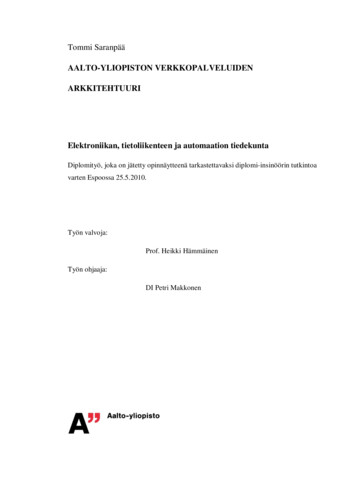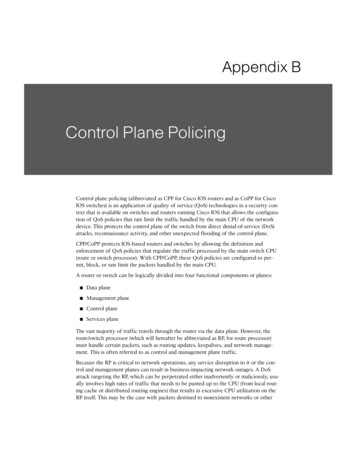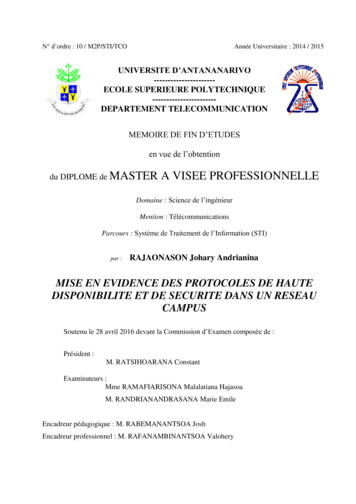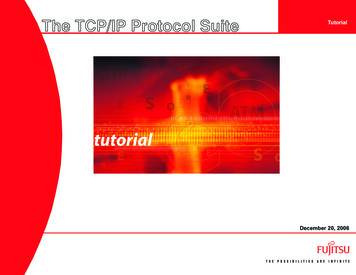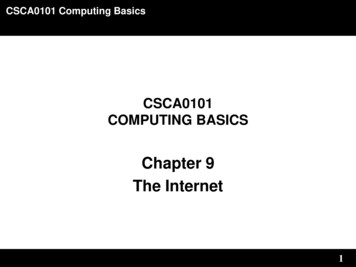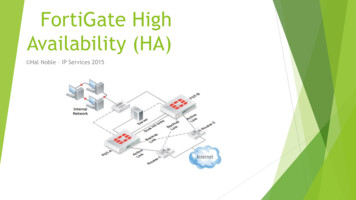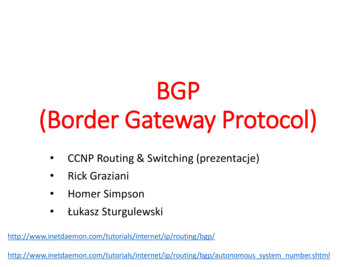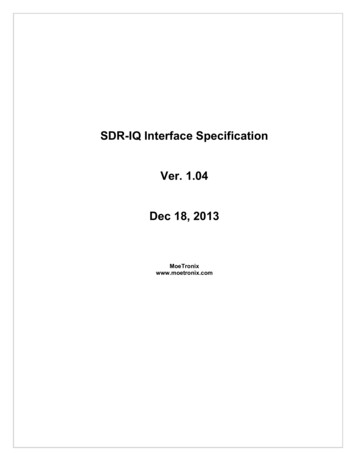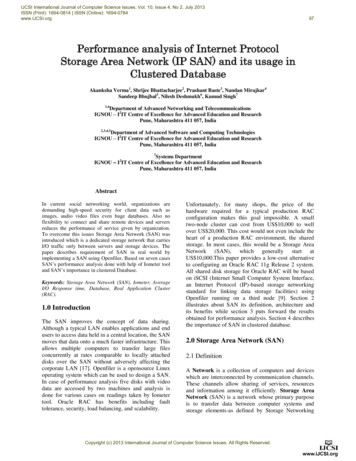
Transcription
IJCSI International Journal of Computer Science Issues, Vol. 10, Issue 4, No 2, July 2013ISSN (Print): 1694-0814 ISSN (Online): 1694-0784www.IJCSI.org97Performance analysis of Internet ProtocolStorage Area Network (IP SAN) and its usage inClustered DatabaseAkanksha Verma1, Shrijee Bhattacharjee2, Prashant Baste3, Nandan Mirajkar4Sandeep Bhujbal5, Nilesh Deshmukh6, Kumud Singh71,6Department of Advanced Networking and TelecommunicationsIGNOU – I2IT Centre of Excellence for Advanced Education and ResearchPune, Maharashtra 411 057, India2,3,4,5Department of Advanced Software and Computing TechnologiesIGNOU – I2IT Centre of Excellence for Advanced Education and ResearchPune, Maharashtra 411 057, India7Systems DepartmentIGNOU – I IT Centre of Excellence for Advanced Education and ResearchPune, Maharashtra 411 057, India2AbstractIn current social networking world, organizations aredemanding high-speed security for client data such asimages, audio video files even huge databases. Also noflexibility to connect and share remote devices and serversreduces the performance of service given by organization.To overcome this issues Storage Area Network (SAN) wasintroduced which is a dedicated storage network that carriesI/O traffic only between servers and storage devices. Thepaper describes requirement of SAN in real world byimplementing a SAN using Openfiler, Based on seven casesSAN’s performance analysis done with help of Iometer tooland SAN’s importance in clustered Database.Keywords: Storage Area Network (SAN), Iometer, AverageI/O Response time, Database, Real Application Cluster(RAC).1.0 IntroductionThe SAN improves the concept of data sharing.Although a typical LAN enables applications and endusers to access data held in a central location, the SANmoves that data onto a much faster infrastructure. Thisallows multiple computers to transfer large filesconcurrently at rates comparable to locally attacheddisks over the SAN without adversely affecting thecorporate LAN [17]. Openfiler is a opensource Linuxoperating system which can be used to design a SAN.In case of performance analysis five disks with videodata are accessed by two machines and analysis isdone for various cases on readings taken by Iometertool. Oracle RAC has benefits including faulttolerance, security, load balancing, and scalability.Unfortunately, for many shops, the price of thehardware required for a typical production RACconfiguration makes this goal impossible. A smalltwo-node cluster can cost from US 10,000 to wellover US 20,000. This cost would not even include theheart of a production RAC environment, the sharedstorage. In most cases, this would be a Storage AreaNetwork (SAN), which generally start atUS 10,000.This paper provides a low-cost alternativeto configuring an Oracle RAC 11g Release 2 system.All shared disk storage for Oracle RAC will be basedon iSCSI (Internet Small Computer System Interface,an Internet Protocol (IP)-based storage networkingstandard for linking data storage facilities) usingOpenfiler running on a third node [9]. Section 2illustrates about SAN its definition, architecture andits benefits while section 3 puts forward the resultsobtained for performance analysis. Section 4 describesthe importance of SAN in clustered database.2.0 Storage Area Network (SAN)2.1 DefinitionA Network is a collection of computers and deviceswhich are interconnected by communication channels.These channels allow sharing of services, resourcesand information among it efficiently. Storage AreaNetwork (SAN) is a network whose primary purposeis to transfer data between computer systems andstorage elements-as defined by Storage NetworkingCopyright (c) 2013 International Journal of Computer Science Issues. All Rights Reserved.
IJCSI International Journal of Computer Science Issues, Vol. 10, Issue 4, No 2, July 2013ISSN (Print): 1694-0814 ISSN (Online): 1694-0784www.IJCSI.orgIndustry Association (SNIA) [1]. A storage areanetwork (SAN) is a dedicated high performancenetwork to facilitate block-level data access. It carriesdata between servers (hosts) and storage devicesthrough switches [2][5].2.2 ArchitectureFig 1: Architecture of Storage Area Network (SAN) [3]The SANs are used to connect shared storage arraysand tape libraries to multiple servers, and are used byclustered servers for failover. A SAN allows direct,high-speed data transfers between servers and storagedevices, potentially in any of the following three ways:1. Server to storage: This is the traditional model ofinteraction with storage devices. The advantage is thatthe same storage device might be accessed serially orconcurrently by multiple servers.2. Server to server: A SAN might be used for highspeed, high-volume communications between servers.3. Storage to storage: This outboard data movementcapability enables data to be moved without serverintervention, therefore freeing up server processorcycles for other activities like application processing[1].The information stored in SAN can be accessed by allservers via Local Area Network (LAN) and Wide AreaNetwork (WAN) so it becomes easy for informationaccessing. IP SAN uses TCP/IP as its media. TheTransmission Control Protocol (TCP) and the InternetProtocol (IP) is part of the backbone of the Internet’ssuite of communication protocols. The advantage of IPSAN is that when it is utilized, networked storage can98be available any place TCP/IP goes. Internet SCSI(iSCSI) uses the SCSI command set to communicatebetween the computing devices and storage, via aTCP/IP network. IP SAN uses TCP as a transportmechanism for storage over Ethernet, and iSCSIencapsulates SCSI commands into TCP packets, thusenabling the transport of I/O block data over IPnetworks [4].Fig 2: iSCSI and IP SAN Architecture [4]2.3 Following are benefits of SAN:1. Removes the distance limits of SCSI-connecteddisks.2. Greater performance.3. Increased disk utilization.4. Higher availability to storage by use of multipleaccess paths.5. Reduced data center rack/floor space.6. New disaster recovery capabilities.7. Online recovery.8. Better staff utilization [18].3.0 Performance analysis of IP SANPerformance analysis of IP SAN can be done with thehelp of Iometer. Iometer is both a workload generator(it performs I/O operations in order to stress thesystem) and a measurement tool (it examines andrecords the performance of its I/O operations and theirimpact on the system). It can be configured to emulatethe disk or network I/O load of any program orbenchmark, or can be used to generate entirelysynthetic I/O loads. It can generate and measure loadson single or multiple (networked) systems [16].Copyright (c) 2013 International Journal of Computer Science Issues. All Rights Reserved.
IJCSI International Journal of Computer Science Issues, Vol. 10, Issue 4, No 2, July 2013ISSN (Print): 1694-0814 ISSN (Online): 1694-0784www.IJCSI.orgIometer can becharacterization of:usedformeasurement99and1. Performance of disk and network controllers.2. Bandwidth and latency capabilities of buses.3. Network throughput to attached drives.4. Shared bus performance.5. System-level hard drive performance.6. System-level network performance.Following are some parameters with their explanationsrequired to study and perform analysis on data.Fig 3: Screenshot of iSCSI statusTotal I/Os per Second: Average number of I/Ooperations per second, averaged over the length of thetest so far.Total MBs per Second: Average number ofMegabytes read and written per second, averaged overthe length of the test so far.Average Latency:a. Average I/O Response Time (ms): Average timebetween initiation and completion of an I/O operation,averaged over the length of the test so far, inmilliseconds.b. Average Read Response Time (ms): Average timebetween initiation and completion of a read operation.c. Average Write Response Time (ms): Average timebetween initiation and completion of a write operation.d. Average Transaction Time (ms): Average timebetween initiation of a request and completion of thecorresponding reply. If there are no replies in theaccess specification, this is the same as Average I/OResponse Time.Fig 4: Screenshot of disks available on a machine on connecting totarget using iSCSI initiator (G,H,I,J,K)% CPU Utilization (total): Percentage of processortime spent executing threads other than the Idle thread(in other words, time spent doing useful work). Alsoknown as % Processor Time [16].While testing various cases some default settings weredone in Iometer1. Maximum disk size 2048000 sectors2. Access specification : Default3. update frequency: 10 seconds4. Run time: 5 minutesSample video data was stored in 5 disks created usingopenfiler and with help of iSCSI initiator all diskswere accessed at Machine 1 (M1) and Machine 2 (M2)following is the image for iSCSI status at target.Fig 5: Screenshot of Volumes in Volume groupCopyright (c) 2013 International Journal of Computer Science Issues. All Rights Reserved.
IJCSI International Journal of Computer Science Issues, Vol. 10, Issue 4, No 2, July 2013ISSN (Print): 1694-0814 ISSN (Online): 1694-0784www.IJCSI.org100Readings were taken for following 7 casesMachine 2: Case 41. Default case: no video streaming2. Multiple machines accessing one same video3. Multiple machines accessing multiple videos(same disk)4. Multiple machines accessing multiple videos(different disks)5. At a time one machine accessing one video6. At a time one machine accessing multiple videos(same disk)7. At a time one machine accessing multiple videos(different disks)Fig 7: Bar chart for Average Latency in Case4 of Machine 2 (LAN)1. For Local Area Network (LAN)2. For Wide Area Network ge% Time (ms)Case1 se2 se3 se4 Case5 se6 se7 able 1: Readings taken when machines are connected in LANCasesMachinesTotalTotalAverage% Time (ms)1Case1 se2 se3 ase4 ase5 se6 ase7 ble 2: Readings taken when machines are connected in WANFor LAN in Case 1 i.e the Default case: no videostreaming the average I/O response time for machine 1M1 is 31.0385 ms and for machine 2 M2 is 30.6459which are maximum as compared to other cases. Forcases 2,3,5,6 where video access is from on disk theresponse time is less but when video is accessed fromdifferent disks the average I/O response time shoots upas seen in cases 4 & 7. Total MBs/sec is high in cases5 & 6 where at a time one machine is accessing onevideo and multiple videos from same disk respectivelyas compared to other cases.Machine 1: Case 4For WAN the average I/O response time is maximumin Case 1 for both machines. And when video accessfrom different disks is involved i.e Cases 4 & 7 theaverage I/O response time is high compared to otherCases. In case of WAN the Total MBs/sec is high inCase 1 as compared to other cases.Fig 6: Bar chart for Average Latency in Case4 of Machine 1 (LAN)Fig 8: Bar chart for Average Latency in Case4 of Machine 1(WAN)Machine 1: Case 4Copyright (c) 2013 International Journal of Computer Science Issues. All Rights Reserved.
IJCSI International Journal of Computer Science Issues, Vol. 10, Issue 4, No 2, July 2013ISSN (Print): 1694-0814 ISSN (Online): 1694-0784www.IJCSI.org101Machine 2: Case 4Fig 9: Bar chart for Average Latency in Case4 of Machine 2(WAN)The Bar charts depicts average write response time incase of LAN or WAN is high as compared to averageread response time or average transaction time.4.0 Oracle Real Application Cluster (RAC)Oracle’s Real Application Clusters (RAC) supportsthe transparent deployment of a single database acrosspools of server, providing fault tolerance fromhardware failures or planned outages [7]. In an OracleRAC environment, two or more computers each withan Oracle Relational Database Management system(RDBMS) instance simultaneously access a singledatabase which makes it possible for an application oruser to connect to either computer and have access to asingle coordinated set of data. The database consists ofa collection of data files, control files, and redo logslocated on disk. The instance comprises the collectionof Oracle-related memory and operating systemprocesses that run on a computer system [8].Fig 10: Architecture of Oracle RAC [10]iSCSI Initiator: An iSCSI initiator is a client devicethat connects and initiates requests to some serviceoffered by a server (in this case an iSCSI target). TheiSCSI initiator software will need to exist on each ofthe Oracle RAC nodes ( racnode1 and racnode2).iSCSI Target: An iSCSI target is the "server"component of an iSCSI network. It is the storagedevice that contains the information you want andanswers requests from the initiator(s). In this projectOpenfiler will be the iSCSI target.4.2 Implementation of Oracle RAC4.1 Usage of SAN in Clustered environmentThe Internet Small Computer System Interface(iSCSI) is an Internet Protocol (IP)-based storagenetworking standard for establishing and managingconnections between IP-based storage devices, hosts,and clients. iSCSI is a data transport protocol definedin the SCSI-3 specifications framework and is similarto Fibre Channel in that it is responsible for carryingblock-level data over a storage network. In Block-levelcommunication data is transferred between the hostand the client in chunks called blocks. Databaseservers depend on this type of communication [9].Oracle Real Application Clusters is a sharedeverything architecture. All servers in the server poolshare all storage used for an Oracle RAC database.The type of storage pool used can be network attachedstorage (NAS), Storage Area Network (SAN), or SCSIdisks [10]. We will be using Storage Area Network(SAN) by Openfiler.Fig 11: Architecture of Implemented Oracle RAC with IP addressesIn Oracle VM VirtualBox [12] both RAC 1 and RAC2 machines are built having Operating systemWindows server 2008 [11] and following softwares1. Oracle Grid Infrastructure 11g Release 22. Oracle Database 11g Release 2 [13]Copyright (c) 2013 International Journal of Computer Science Issues. All Rights Reserved.
IJCSI International Journal of Computer Science Issues, Vol. 10, Issue 4, No 2, July 2013ISSN (Print): 1694-0814 ISSN (Online): 1694-0784www.IJCSI.org1024.3.4 Time required to put 10 lakh records in RACdatabase from node1 and node2 simultaneously.NodesNode 1Node 2For Tabletemp9temp10TimeTc2 2:53.70 Td2 3:26.97Table 4: Time taken to put data in RAC simultaneouslyFig 12: Screenshot of Active Instances in RAC4.3 Time based analysis of retrieve and display dataFirst we will put 10 lakh records in single machinedatabase (non-RAC environment).create table temp (no int);Now using PL-SQL commands to put 10 lakh recordsBEGINFOR i in 1.1000000 LOOPINSERT INTO temp(no) VALUES (i);END LOOP;COMMIT;END;4.3.1 Time required to put 10 lakh records in singlemachine database in minutes:secondsTa 1:11.804.3.2 Time required to retrieve and display data insingle machine database.select * from temp;T1 2:30.65T2 2:30.55T3 2:28.55T4 2:29.55T5 2:29.18The average time Tb 2:29.69Now we will put 10 lakh records in tables temp7 fromNode 1 and temp8 from Node 2 in RAC database andget retrieve and display results.4.3.3 Time required to put 10 lakh records in RACdatabase from node1 and node2 not simultaneouslyNodesNode 1Node 2For Tabletemp7temp8TimeTc1 3:12.39 Td1 3:51.60Table 3: Time taken to put data in RACAs we can compare Ta with Tc’s & Td’s it proves thattime required to put data in RAC environment is morethan time required to put data in single machinedatabase. From above readings it can analyzed thattime difference between nodes is negligible in RACenvironment hence as much as nodes increaseperformance remains same. In case of productionenvironment with Fibre channel speed increasestremendously hence multiple nodes can insert data atsame time without any data corruption.4.3.5 Time required to retrieve and display data inRAC environmentCase 1: RAC environment in LAN (Local AreaNetwork) and nodes accessing same data [14]TimeNode 1Node 5:16.466:53.76AccessT45:15.466:45.18of dataT55:01.897:01.29Average Tm 6:13.04 Tn 3AccessT36:57.667:18.99of dataT47:00.747:26.98T57:02.117:21.08Average To 7:06.38 Tp 7:34.14Table 5: Time taken to retrieve & display data from RAC(LAN same data)Case 2: RAC environment in LAN (Local AreaNetwork) and nodes accessing different data [14]TimeNode 1Node 5:27.996:28.76AccessT45:29.126:14.91of dataT55:21.686:19.42Average Tq 5:37.12 Tr 8AccessT34:25.137:09.28of dataT44:24.676:56.37T54:32.907:03.11Average Ts 4:28.77Tt 7:01.79Table 6: Time taken to retrieve & display data from RAC(LAN different data)Copyright (c) 2013 International Journal of Computer Science Issues. All Rights Reserved.
IJCSI International Journal of Computer Science Issues, Vol. 10, Issue 4, No 2, July 2013ISSN (Print): 1694-0814 ISSN (Online): 1694-0784www.IJCSI.orgThe above 2 cases proves even in case of retrieve anddisplay of data, time delay is minimum, data can beaccessed from many servers simultaneously withoutcorruption. The major advantage here is that data isstored in a centralized storage and multiple nodes canperform transactions on that data through network.Hence RAC provides high availability i.e If a node ina server pool fails, the database continues to run on theremaining server in the pool [7].5. ConclusionThe paper clearly illustrates the performance analysisof SAN considering seven cases and its importance ascentralized storage access to all nodes in case ofclustered database. The cost and complexity of FibreChannel has kept SAN deployment out of reach forsmall and midsized businesses until the introduction ofStorage over IP (SoIP) SANs based on the iSCSIprotocol approved by the Internet Engineering TaskForce (IETF) in 2003. In case of security FibreChannel SANs are traditionally less secure than iSCSI.Fibre Channel SAN can see multiple LUNs on anyparticular disk, but iSCSI can only deal with a disktarget. Consequently, iSCSI authentication is n methods to establish security, such asChallenge Handshake Authentication Protocol(CHAP). Fibre Channel does not support native103encryption over the wire, but iSCSI can utilize IPSecencryption to protect data in flight [6]. In SAN if allthe hosts are allowed to access all the drives the twoimportant problems arise they are disk resourcecontention and data corruption. To deal with them onecan isolate and protect storage devices on a SAN byusing zoning and LUN (Logical Unit Number)masking, which allows to dedicate storage devices onthe SAN to individual servers. Zoning: Many devicesand nodes can be attached to a SAN, When data isstored in a single cloud, or storage entity, it isimportant to control which hosts have access tospecific devices. Zoning implemented at the hardwarelevel, isolates a single server to a group of storagedevices or a single storage device, or associate agrouping of multiple servers with one or more storagedevices, as required in a server cluster deployment.LUN masking: performed at the storage controllerlevel, allows to define relationships between LUNsand individual servers. Storage controllers usuallyprovide the means for creating LUN-level accesscontrols that allow access to a given LUN by one ormore hosts. By providing this access control at thestorage controller, the controller itself enforces accesspolicies to the devices. LUN masking provides moredetailed security than zoning, because LUNs provide ameans for sharing storage at the port level [15]. SANholds its importance even in this Cloud era and willcontinue to provide optimum service to end users.Fig 13: Screenshot of disk available in RACFig 14: Screenshot of disk statisticsCopyright (c) 2013 International Journal of Computer Science Issues. All Rights Reserved.
IJCSI International Journal of Computer Science Issues, Vol. 10, Issue 4, No 2, July 2013ISSN (Print): 1694-0814 ISSN (Online): 1694-0784www.IJCSI.orgReferences[1] Introduction to Storage Area Networks and SystemNetworking Jon Tate Pall Beck Hector Hugo IbarraShanmuganathan Kumaravel Libor Miklas IBM FifthEdition (November 2012) Copyright InternationalBusiness Machines Corporation 2012.All rights reserved.[2] http://en.wikipedia.org/wiki/Storage area network[last modified 6 June 2013][3] http://www.allsan.com/sanoverview.php3[last modified 6 June 2013][4] http://www.tns.com/ip san.asp[last modified 25 June 2013][5] Information Storage and Management Participant guidevolume 1 of 2 student guide EMC2 July 2009[6] http://www.cuttedge.com/files/iscsi vs fiberchannel explain.pdf [last modified 24 June 2013][7] Oracle Real Application Cluster , Oracle Data SheetCopyright 2010, Oracle and/or its affiliates.All rightsReserved.[8] http://en.wikipedia.org/wiki/Oracle RAC[last modified 6 June 2013][9] rac11gr2-iscsi-088677.html[last modified 6 June 2013][10] An Oracle White Paper November 2010 Oracle RealApplication Clusters (RAC) 11g Release 2 Author:Barb Lundhild, Markus Michalewicz Copyright 2010, Oracle and/or its affiliates. All rights reserved[11] s-server/2008-r2-trial.aspx[last modified 6 June 2013][12] https://www.virtualbox.org/[last modified 10 June 2013][13] ise-edition/downloads/index.html[last modified 10 June 2013][14] http://www.csgnetwork.com/timescalc.html[last modified 10 June 2013][15] 0(v ws.10).aspx[last modified 10 June 2013][16] http://csis.pace.edu/ meter.pdf[last modified 10 June 2013]104[17] /4017917/Storage-Area-Network-Overview[last modified 23 June 2013][18] http://media.wiley.com/product data/excerpt/38/04703851/0470385138.pdf[last modified 23 June 2013]First Author: Ms. Akanksha Verma, She is pursuingM.Tech in Advanced Information Technology withspecialization in Networking and Telecommunications fromIGNOU – I2IT Centre of Excellence for Advanced Educationand Research, Pune, India. She completed B.E ComputerScience and Engineering (CSE) from Rajiv GandhiProudyogiki Vishwavidyalaya (RGVP). Her research interestincludes Storage Area Network (SAN) and Networking.Second Author: Ms. Shrijee Bhattacharjee, She ispursuing M.Tech in Advanced Information Technology withspecialization in Software Technologies from IGNOU – I2ITCentre of Excellence for Advanced Education and Research,Pune, India. She completed B.Tech Computer Science andEngineering (CSE) from North Eastern Hill University(NEHU). Her research interest includes Cloud Computing,Database Management System, Data Mining and BusinessIntelligence.Third Author: Mr. Prashant Baste, He is pursuing M.Techin Advanced Information Technology with specialization inSoftware Technologies from IGNOU–I2IT Centre ofExcellence for Advanced Education and Research, Pune,India. He completed B.E Computer Science and Engineeringfrom University of Pune. His research interests includedatabases, data mining and cloud computing.Fourth Author: Mr. Nandan Nagarajappa Mirajkar, He ispursuing M.Tech in Advanced Information Technology withspecialization in Software Technologies from IGNOU – I2ITCentre of Excellence for Advanced Education and Research,Pune, India. He is also Teaching Assistant in AdvancedSoftware and Computing Technologies Department. Hecompleted B.E Electronics and Telecommunications fromUniversity of Mumbai. His research interests include Cloudcomputing, Databases and Networking.Fifth Author: Mr. Sandeep Bhujbal, He is Sr. ResearchAssociate in Advanced Software and ComputingTechnologies Department of IGNOU – I2IT Centre ofExcellence for Advanced Education and Research, Pune,India. He completed M.C.S from University of Pune. Hisresearch interests include Operating systems, Compilerconstruction, Programming languages and Cloud computing.Sixth Author: Mr. Nilesh Deshmukh, He is SeniorLecturer in Advanced Software and ComputingTechnologies Department of IGNOU – I2IT Centre ofExcellence for Advanced Education and Research, Pune,India. He completed APGP from I2IT and B.E ComputerScience from Amravati University. His research interestsinclude Storage Area Network (SAN) and Networking.Seventh Author: Mr. Kumud Singh, He is Senior ExecutiveIT Infrastructure Services in IGNOU – I2IT Centre ofExcellence for Advanced Education and Research Pune,Maharashtra, India. He completed BCA from GIMT Delhi,India. His key interests are in Virtualization and Networksecurity.Copyright (c) 2013 International Journal of Computer Science Issues. All Rights Reserved.
Storage Area Network (SAN) is a network whose primary purpose is to transfer data between computer systems and storage elements-as defined by Storage Networking . IJCSI International Journal of Computer Science Issues, Vol. 10, Issue 4, No 2, July 2013 ISSN (Print): 1694-0814 ISSN (Online): 1694-0784 www.IJCSI.org 97
